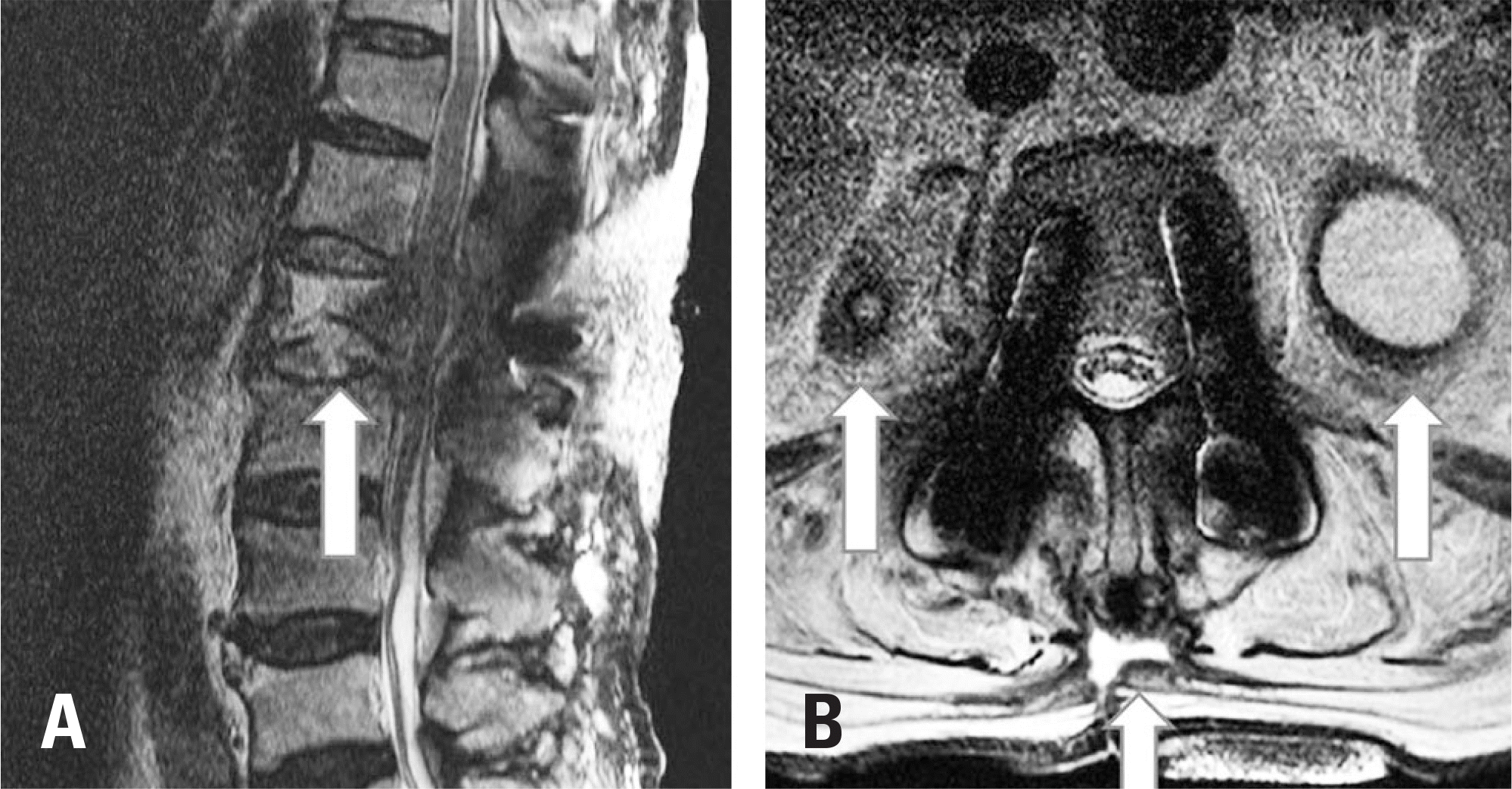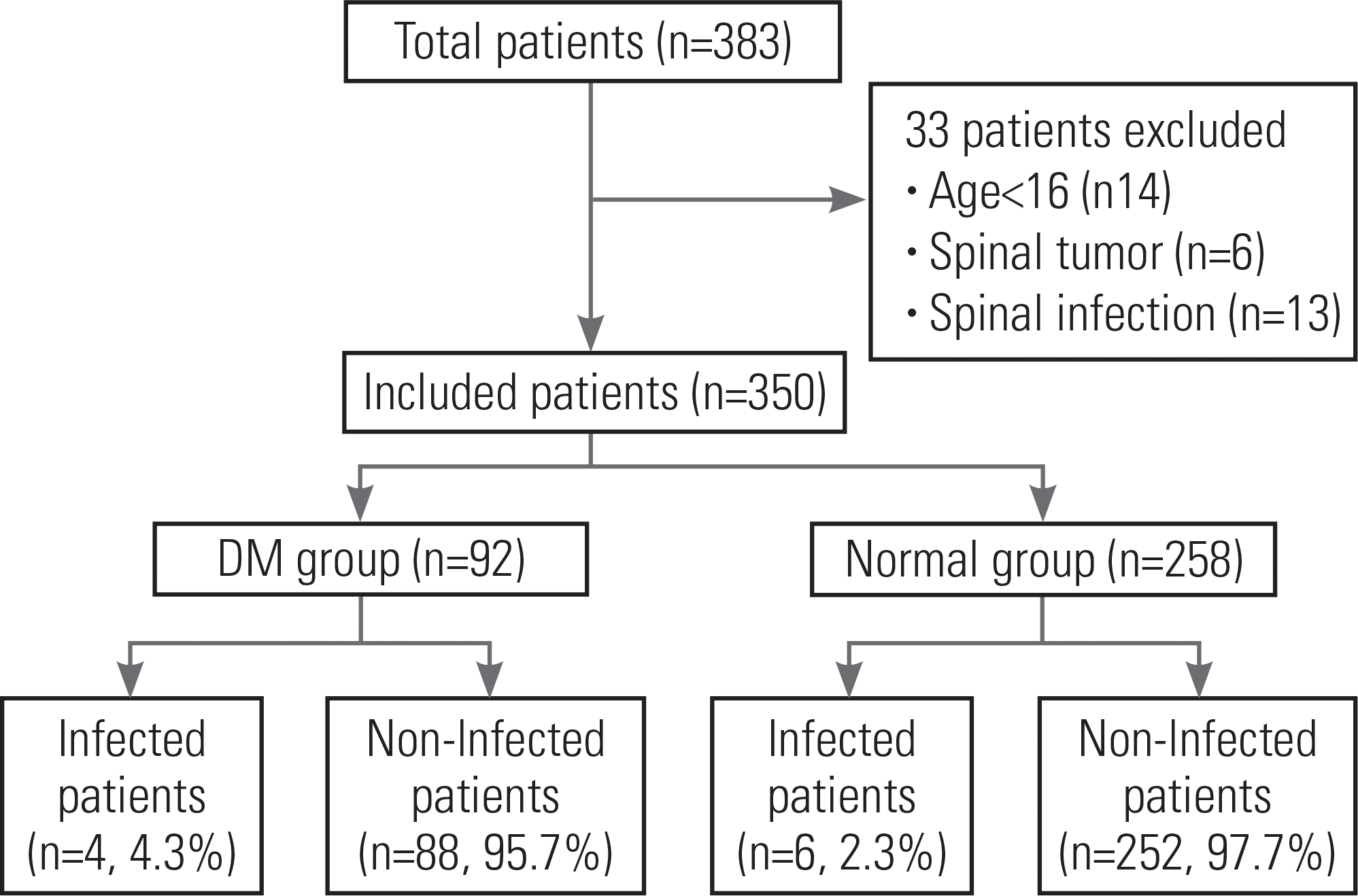Abstract
Summary of the Literature Review
Infection after spinal surgery is relatively uncommon. However, such infections cause serious consequences and increased costs and sequelae. Risk factors for infection after spinal surgery include a posterior approach, instrumentation, the use of an allogenic bone graft, transfusion, and a long operating time. Patient-related factors include diabetes and obesity.
Materials and Methods
From January 2009 to December 2013, 350 patients who underwent surgery at our hospital due to spinal disease, including 10 patients with a postoperative spinal infection, were evaluated. We investigated patients’ age, gender, morbidity due to diabetes mellitus, body mass index, level of surgery, approach, location, instrumentation, and operation type.
Results
Ten of the 350 patients developed a spinal infection after surgery. The proportion of diabetic patients among the infected patients was higher than among the non-infected patients, although the difference was not statistically significant. Additionally, the proportion of diabetic patients with hemoglobin A1c levels greater than 7.0% was higher among the infected patients. Operating time, the surgical approach, drain tube insertion, transfusion, and the use of an allogenic bone graft were not significantly different between the infected and non-infected patient groups.
Go to : 
REFERENCES
1. Brown EM, Pople IK, de Louvois J, et al. Spine update: prevention of postoperative infection in patients undergoing spinal surgery. Spine (Phila Pa 1976). 2004 Apr 15; 29(8):938–45. DOI: 10.1097/00007632-200404150-00023.
2. Collins I, Wilson-MacDonald J, Chami G, et al. The diagnosis and management of infection following instrumented spinal fusion. Eur Spine J. 2008 Mar; 17(3):445–50. DOI: 10.1007/s00586-007-0559-8.

3. Haridas M, Malangoni MA. Predictive factors for surgical site infection in general surgery. Surgery. 2008 Oct; 144(4):496–501. discussion -3. DOI: 10.1016/j.surg.2008.06.001.

4. Kanayama M, Hashimoto T, Shigenobu K, et al. Effective prevention of surgical site infection using a Centers for Disease Control and Prevention guideline-based antimicrobial prophylaxis in lumbar spine surgery. J Neurosurg Spine. 2007 Apr; 6(4):327–9. DOI: 10.3171/spi.2007.6.4.7.

5. Olsen MA, Nepple JJ, Riew KD, et al. Risk factors for surgical site infection following orthopaedic spinal operations. J Bone Joint Surg Am. 2008 Jan; 90(1):62–9. DOI: 10.2106/jbjs.F.01515.

6. Schuster JM, Rechtine G, Norvell DC, et al. The influence of perioperative risk factors and therapeutic interventions on infection rates after spine surgery: a systematic review. Spine (Phila Pa 1976). 2010 Apr 20; 35(9 Suppl):S125–37. DOI: 10.1097/BRS.0b013e3181d8342c.
7. Kasliwal MK, Tan LA, Traynelis VC. Infection with spinal instrumentation: Review of pathogenesis, diagnosis, prevention, and management. Surg Neurol Int. 2013; 4(Suppl 5):392–403. DOI: 10.4103/2152-7806.120783.

8. Owens BD, White DW, Wenke JC. Comparison of irrigation solutions and devices in a contaminated musculoskeletal wound survival model. J Bone Joint Surg Am. 2009 Jan; 91(1):92–8. DOI: 10.2106/jbjs.G.01566.

9. Ahn DK, Choi DJ, Park HS, et al. Precautions against infection following posterior spinal fusion based on types of infection and risk factors. J Korean Soc Spine Surg. 2009; 16(4):274–84.

10. Fang A, Hu SS, Endres N, et al. Risk factors for infection after spinal surgery. Spine (Phila Pa 1976). 2005 Jun 15; 30(12):1460–5. DOI: 10.1097/01.brs.0000166532.58227.4f.

11. Friedman ND, Sexton DJ, Connelly SM, et al. Risk factors for surgical site infection complicating laminectomy. Infect Control Hosp Epidemiol. 2007 Sep; 28(9):1060–5. DOI: 10.1086/519864.

12. Kanafani ZA, Dakdouki GK, El-Dbouni O, et al. Surgical site infections following spinal surgery at a tertiary care center in Lebanon: incidence, microbiology, and risk factors. Scand J Infect Dis. 2006; 38(8):589–92. DOI: 10.1080/00365540600606440.

13. Klekamp J, Spengler DM, McNamara MJ, et al. Risk factors associated with methicillin-resistant staphylococcal wound infection after spinal surgery. J Spinal Disord. 1999 Jun; 12(3):187–91. DOI: 10.1097/00002517-199906000-00002.

14. Liao JC, Chen WJ, Chen LH, et al. Postoperative wound infection rates after posterior instrumented spinal surgery in diabetic patients. Chang Gung Med J. 2006 Sep-Oct; 29(5):480–5.
15. Olsen MA, Mayfield J, Lauryssen C, et al. Risk factors for surgical site infection in spinal surgery. J Neurosurg. 2003 Mar; 98(2 Suppl):149–55.

16. Hikata T, Iwanami A, Hosogane N, et al. High preoperative hemoglobin A1c is a risk factor for surgical site infection after posterior thoracic and lumbar spinal instrumentation surgery. J Orthop Sci. 2014 Mar; 19(2):223–8. DOI: 10.1007/s00776-013-0518-7.

17. Delamaire M, Maugendre D, Moreno M, et al. Impaired leucocyte functions in diabetic patients. Diabet Med. 1997 Jan; 14(1):29–34. DOI: 10.1002/(sici)1096-9136 (199701)14: 1< 29:: Aid-dia300> 3.0.Co; 2-v.

18. Bagdade JD, Stewart M, Walters E. Impaired granulocyte adherence. A reversible defect in host defense in patients with poorly controlled diabetes. Diabetes. 1978 Jun; 27(6):677–81. DOI: 10.2337/diabetes.27.6.677.

19. Mowat A, Baum J. Chemotaxis of polymorphonuclear leukocytes from patients with diabetes mellitus. N Engl J Med. 1971 Mar 25; 284(12):621–7. DOI: 10.1056/nejm197103252841201.

20. Sima AA, O'Neill SJ, Naimark D, et al. Bacterial phagocytosis and intracellular killing by alveolar macrophages in BB rats. Diabetes. 1988 May; 37(5):544–9. DOI: 10.2337/diab.37.5.544.

21. Twigg SM, Chen MM, Joly AH, et al. Advanced glycosylation end products up-regulate connective tissue growth factor (insulin-like growth factor-binding protein-related protein 2) in human fibroblasts: a potential mechanism for expansion of extracellular matrix in diabetes mellitus. Endocrinology. 2001 May; 142(5):1760–9. DOI: 10.1210/endo.142.5.8141.

22. Laing P. Diabetic foot ulcers. Am J Surg. 1994 Jan; 167(1 Suppl):31–6. DOI: 10.1016/0002-9610 (94)90008-6.

23. Keller RB, Pappas AM. Infection after spinal fusion using internal fixation instrumentation. Orthop Clin North Am. 1972 Mar; 3(1):99–111.

24. Lonstein J, Winter R, Moe J, et al. Wound infection with Harrington instrumentation and spine fusion for scoliosis. Clin Orthop Relat Res. 1973 Oct. (96): 222–33. DOI: 10.1097/00003086-197310000-00032.

25. Moe JH. Complications of scoliosis treatment. Clin Orthop Relat Res. 1967 Jul-Aug; 53:21–30. DOI: 10.1097/00003086-196707000-00004.
26. Prothero SR, Parkes JC, Stinchfield FE. Complications after low-back fusion in 1000 patients: A comparison of two series one decade apart. J Bone Joint Surg Am. 1966; 48:57–65. DOI: 10.2106/00004623-196648010-00004.
27. Ho C, Sucato DJ, Richards BS. Risk factors for the development of delayed infections following posterior spinal fusion and instrumentation in adolescent idiopathic scoliosis patients. Spine (Phila Pa 1976). 2007 Sep 15; 32(20):22727. DOI: 10.1097/BRS.0b013e31814b1c0b.

28. Chang HJ, Nam JH, Kim DY, et al. The effect of surgical scrub in orthopaedic surgery. J Korean Orthop Assoc. 2014 Feb; 49(1):36–42. DOI: 10.4055/jkoa.2014.49.1.36.

Go to : 
 | Fig. 2.Magnetic resonance imaging (sagittal view, axial view) shows osteomyelitis of the L3 vertebra body (A) and large fluid collection on both psoas muscles (B) in an 86-year-old patient who had posterior fusion from T12 to L3. |
Table 1.
Demographics in the two groups; surgical site infection group, non-surgical site infection group
Table 2.
Demographics in the two groups; uncontrolled DM group, controlled DM group




 PDF
PDF Citation
Citation Print
Print



 XML Download
XML Download